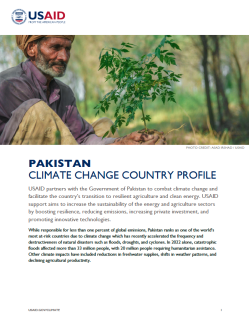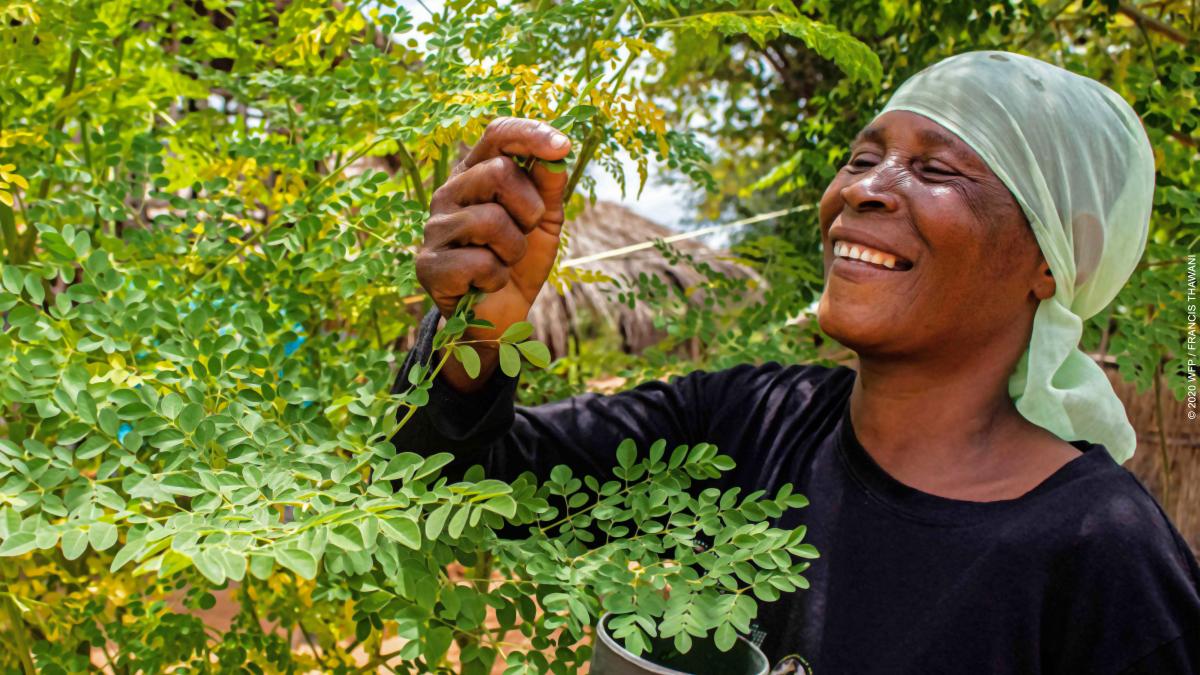While responsible for less than one percent of global emissions, Pakistan ranks as one of the world’s most at-risk countries due to climate change which has recently accelerated the frequency and destructiveness of natural disasters such as floods, droughts, and cyclones. In 2022 alone, catastrophic floods affected more than 33 million people, with 20 million people requiring humanitarian assistance. Other climate impacts have included reductions in freshwater supplies, shifts in weather patterns, and declining agricultural productivity.
Government of Pakistan Climate Priorities
At the 2021 United Nations Climate Change Conference (COP 26), the Government of Pakistan declared that it would aim for a 50 percent reduction in greenhouse gas emissions by 2030—including a 15 percent target reduction using the country’s own resources and a 35 percent target reduction subject to availability of international grant finance. To achieve this goal, the Government of Pakistan has signaled that it will ban coal imports, expand nature-based solutions, transition to 60 percent renewable energy, and aim to have electric vehicles account for 30 percent of the country’s total vehicle fleet.
The country’s National Adaptation Plan highlights the need to give local communities better tools to strengthen their climate resilience. These efforts include boosting the green economy, building sustainable infrastructure and services, promoting technology and innovation, and encouraging collaboration between government, private sector, and civil society.
USAID’S Climate Change Program: Objectives and Results
USAID is working with the Government of Pakistan to achieve their climate and development goals by strengthening programs and partnerships in the water management, agriculture, finance, and renewable energy sectors.
Adaptation
In collaboration with the Government of Pakistan and provincial governments, the private sector, and communities, USAID has made substantial investments in the water and agriculture sectors that build adaptation capacity of systems, infrastructure, and people to more effectively cope with not only climate change, but also intensifying demand for food and water.
Key Results and Programs
USAID has helped:
- Increase national water storage capacity by eight percent—or 1.2 million acre feet—through the construction of the Satpara and Gomal Zam dams; during the 2022 flood, the Gomal Zam Dam reservoir saved more than 1 million lives by capturing stormwater which otherwise would have contributed to flooding
- Construct more than 400 kilometers of irrigation canals, irrigating more than 200,000 acres and helping more than 1 million farmers increase productivity
- Install and operate, in partnership with the provincial government of Khyber Pakhtunkhwa, a telemetric system on irrigation canals—the first-ever provincial telemetry system—to improve water accounting and resolve water-related conflicts
- Deliver access to clean water to more than 1 million Pakistanis and provide access to improved sanitation facilities to more than 2 million Pakistanis, in partnership with provincial governments of Khyber Pakhtunkhwa and Sindh
- Support informed decision-making and applied research by funding research programs which led to the publication of nine peer-reviewed articles on water and climate change; USAID-funded researchers also presented the results of these studies to policymakers and academia through consultative workshops
- Leverage $66 million in Green Climate Fund resources to reduce flood and drought risk across the Indus Basin, in partnership with the World Wildlife Fund and Coca Cola
- Launch the Pakistan Climate Financing Activity, a four-year, $10 million endeavor aimed at mobilizing investment to strengthen climate resilience in Pakistan
- Provide livelihood support, access to climate-resilient high-yielding crop varieties, and training on better farm management practices to more than 1 million households
- Enable over 900,000 farmers to use improved management practices and technologies on their farms
- Introduce climate-resilient, nutrient-rich varieties of maize, wheat, rice, and cotton to strengthen food and nutrition security and bolster climate adaptation.
- Train 14 students at U.S. land grant universities to educate the next generation of Pakistani agricultural leaders
- Support the drafting and adoption of critical provincial-level and federal government agriculture policies, including the first Punjab Agriculture Policy, first Pakistan Water Policy, and Seed Act Amendment
- Train government officials in data collection and management, digital modeling, and policy analysis tools to promote evidence-based decision-making and policies
Renewable Energy
Key Results and Programs
Since 2010, USAID has partnered with the Government of Pakistan to address the energy demand-and-supply crisis that has crippled the country's economy and disrupted the lives of many Pakistanis. Today, in partnership with the Government of Pakistan USAID is increasing power system capacity and creating the necessary policy, legal and regulatory frameworks to attract private investment in clean energy, increase energy efficiency, and expand energy access. USAID also supports the country’s transition to affordable and sustainable energy that reduces emissions, spurs economic growth, and provides power to businesses and health and education systems.
USAID has helped:
- Enhance energy access for 48 million people
- Add approximately 4,200 megawatts of power capacity to the national grid through generation and transmission projects.
- Leverage more than $2.7 billion of investment through infrastructure support and advisory services to help private sector entities complete wind and solar projects
- Construct 288 kilometers of power transmission lines, connecting Pakistan’s first wind energy corridor to the national grid
- Support the implementation of more than 30 policies and regulations that strengthened the clean energy sector
- Reduce or avoid 55 million tons of projected greenhouse gas emissions
- Mobilize nearly $40 million for clean energy projects in FY 2023
For More Information




